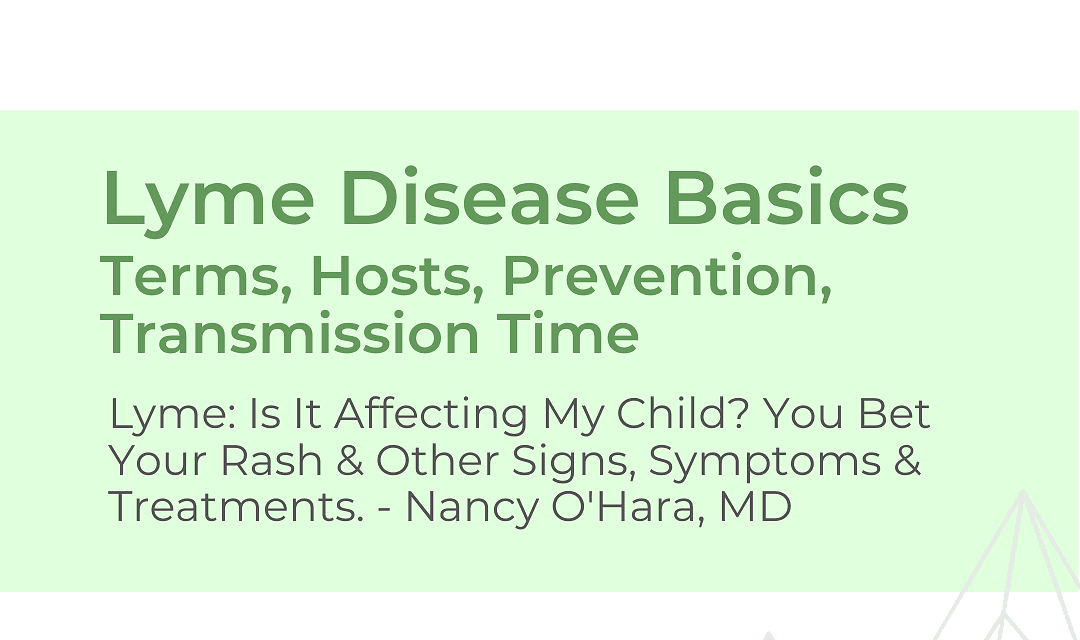Lyme Disease Basics – Dr. O’Hara

Section 1: Lyme Disease Basics
Nancy O’Hara, MD, MPH, FAAP, a member of the ASPIRE Professional Advisory Board, presented on Lyme Disease, Tick-Borne Illness and Co-infections as part of the NECH Educational Series. This presentation is divided into 5 separate posts.
- Lyme Terminology
- Hosts of Lyme Disease
- Attachment – Transmission Time
- Prevention
- Lyme Disease Fundamentals – Section Links
Lyme Terminology
- Early Lyme – localized or nondisseminated
- Late Lyme
- May have been undiagnosed, misdiagnosed, undertreated
- Disseminated and untreated
- Symptoms – CDC- 60% joints, 15% neuropsychiatric, and cardiac
- Persistent Lyme or new symptoms even with treatment
- Chronic Lyme
- Post Treatment Lyme Disease Syndrome (PTLDS)
- Multiple Systemic Infectious Disease Syndrome (MSIDS)
- Chronic Inflammatory Response Syndrome (CIRS)
Lyme disease and PANS/PANDAS are very similar in that they are both multisystem diseases that can manifest as neuropsychiatric disorders. Lyme disease has a waxing and waning course, just as we see in PANS/PANDAS. Unlike PANS/PANDAS though it is often more subacute and not of abrupt onset. It can have a multisystem pathology. We are most interested in the neuropsychiatric pathology.
Early Lyme can be localized or nondisseminated. Disseminated means having spread throughout an organ or the body. In late Lyme, 60% have joint or musculoskeletal disease and 15% with neuropsychiatric problems. In our practice, 100% of the patients have neuropsychiatric symptoms because of the nature of our practice and our referrals. I actually think late Lyme or the disseminated Lyme when it is neurologic is greatly misdiagnosed, under-diagnosed or under-appreciated.
There can be persistent Lyme, which is when you’ve treated, but the symptoms persist. Some of this symptom persistence is a result of chronic Lyme, while some is multisystemic infectious disease, similar to what we see post-COVID. Some of this is because of other diseases like mold, and some of this is post-treatment Lyme disease syndrome. So those are all important to understand as we treat somewhat differently.
Hosts of Lyme Disease
- >22 species of borrelia
- Ixodes transmitted tick-borne disease
- Borrelia burgdoferi, Miyamoto, mayonii
- Babesia, Ehrlichia, Bartonella, Anaplasma
- Ixodes have a variety of hosts
- Mice, rats, shrew, squirrels
- Incidental hosts – Humans, domesticated animals, lizards
- Gestational
- Tick dispersed over wide distances
- Songbirds, deer
There are many species we know including different species of borrelia and probably another few dozen co-infections. It is mainly a tick-borne disease. But it can also be carried via field mice. That’s a very important exposure in our area, but also rats, squirrels, and shrews. Hosts become other humans – jumping from human to human or domesticated animals. It can be passed gestationally. Many species of songbirds disperse ticks over a wide area just as deer do.
Attachment – Transmission Time
- No guaranteed minimum transmission rate
- Longer tick is attached, the greater the risk of transmission
- Under 24 hours – 7% transmission risk
- 60 hours – 50% transmission risk
We used to say that if a tick was on for less than 24 hours, it was not a problem. There is no guaranteed minimum, although the longer the tick is on, the higher the transmission rate. The Borellia spirochete or Lyme co-infection can well be transmitted within the first 24 hours. 7% of tick-borne infection is transmitted in less than 24 hours. One of our newer borrelia species, borrelia miyamatoi, does not to be fully engorged to transmit.
Prevention
- Most are unaware they have been bitten
- Know endemic areas and assume they are there
- Garlic, cilantro on clothing
- Protection via clothing – tuck in pants, long sleeves, hats
- Tick Checks Daily
Prevention is most important. I’m always happier when I find a tick than when I don’t in this area of the country because we are definitely in an endemic area. You should know if your area is endemic for ticks. If you’re going outside, garlic and cilantro are protective if put on clothing like bandanas you wear around your neck or pants that you may have tucked in your socks. Tucking pants in is great, wearing hats, wearing long sleeves, all of those can be really, really important. Hopewell Pharmacy sells a great natural tick spray that can be very helpful and is one we use quite frequently.
Lyme Disease Fundamentals – Section Links
- Section 2: ILADS Lyme Disease Guidance
- Section 3: MSIDS & Chronic Lyme
- Section 4: Lyme Treatment – Overview of Literature Review
- Section 5: Co-Infections Overview